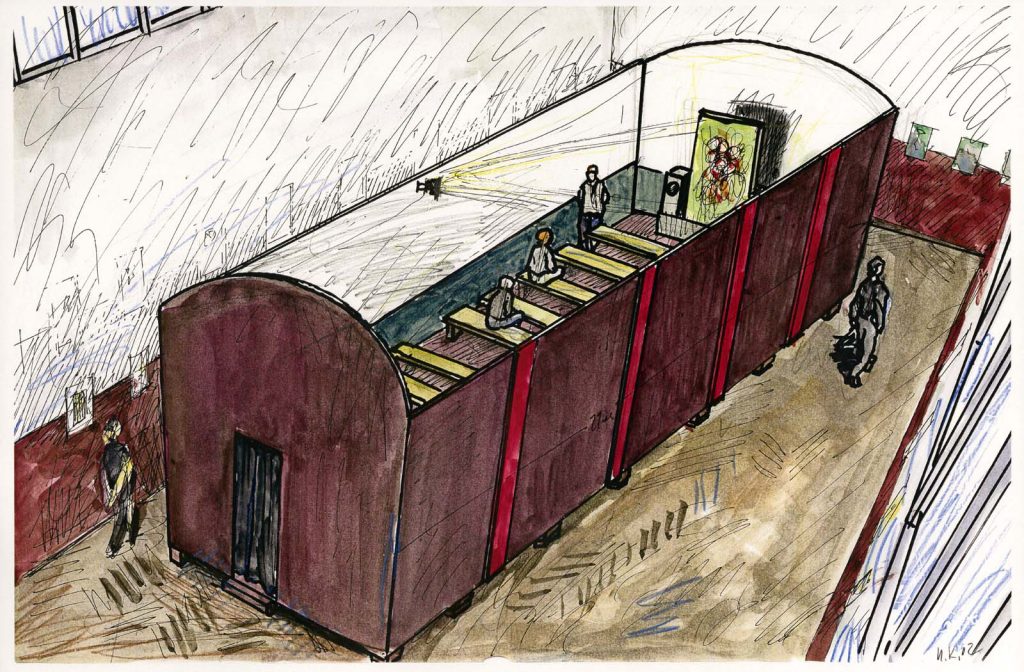Let’s Go Girls
with Emilia Kabakov
YEAR: 2003
CATALOGUE NUMBER: 168
PROVENANCE
Collection of Van Abbemuseum, Eindhoven.
NOTES
See CRP, vol. 1, no. 261, p. 332.
As part of the installation Three Songs for the Motherland, the work Let’s Go Girls! was also part of the installations, We Are Living Here and Unrealized Projects. As part of We Are Living Here, it was furthermore part of Monument to a Lost Civilization.
See CRI, vol. 2, no. 82 (no. 3), pp. 52–59; no. 86, pp. 76–83; no. 141 (Section 1, no. 2), pp. 356–363.
EXHIBITIONS
Schirn Kunsthalle Frankfurt, Frankfurt am Main, Germany
Traumfabrik Kommunismus: Die Visuelle Kultur der Stalinzeit / Dream Factory Communism: The Visual Culture of the Stalin Era,September 24, 2003 to January 4, 2004.
Van Abbemuseum, Eindhoven, Netherlands
Lissitzky – Kabakov: Utopie en Werkelijkheid / Lissitzky – Kabakov: Utopia and Reality, December 1, 2012, to April 1, 2013 (elements of the installation slightly modified).
DESCRIPTION
The train car is 11 x 5 meters in size and resembles a movie hall inside: there are rows of wooden benches, but instead of a screen there is a painting that is not hanging but standing vertically, depicting girls against the backdrop of a pond. There are two speakers on the sides of the painting from which the same lyrical songs of the 1940s and 1950s keep playing over and over. The lighting in the train car plays a definitive role. Rays from lamps placed on the two opposite walls illuminate the painting, and in the semi-dark space, it looks like a movie or television screen, a screen from which, like a freeze-frame, the same depiction never moves.
CONCEPT OF THE INSTALLATION
The train car for the exhibit in “Schirn” has an analogy corresponding directly to the propagandist train cars of the time of the Russian Revolution and the beginning of the civil war. Such cars would course along the railway tracks from station to station, reaching even the most distant ones… The interior of such train cars is well known from photographs: there are tables with propagandist literature, the walls are covered with posters and slogans, there is a movie projector with a screen, simple wooden furniture. The goal of such a train car, or of the entire train, was to “open the eyes” of the doubting and distrustful viewer to his dark and bleak “present” and to the bright, shining “future” which the Bolsheviks were bringing to them and to the country.
The traditions of such closed train cars where ritual ideological “actions” would take place were preserved over the entire course of the existence of Soviet power, later in the form of the “red corners” that were obligatory and which had to exist in every single organization or educational institution. But the actual “action” in them changed from the early years of the revolution. “Shining tomorrow” was replaced by “eternally shining today” and the visitors to the “corners” no longer had to be dragged into the “future,” since for a long time now, from the day of their birth, they were already living in this “wonderful present” that they knew would never change.
That is why the train car “Come on, girls!” was built as a place of the concentrated presence of this “eternal present.” That’s why the painting screen (a screen that shows the same thing over and over) has to shine “eternally,” illuminated by the projector, and the “girls’ lyrical voices” have to resound from the speakers eternally, cyclically, repeating themselves. And the main thing is that this space will eternally be overflowing with the positive energy of happiness and joy that are entirely synonymous with an achieved paradise. We hope that this last aspect will “work” today.
Images
Literature









